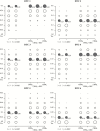A statistical evaluation of dose expansion cohorts in phase I clinical trials
- PMID: 25710960
- PMCID: PMC4565529
- DOI: 10.1093/jnci/dju429
A statistical evaluation of dose expansion cohorts in phase I clinical trials
Abstract
Background: Phase I trials often include a dose expansion cohort (DEC), in which additional patients are treated at the estimated maximum tolerated dose (MTD) after dose escalation, with the goal of ensuring that data are available from more than six patients at a single dose level. However, protocols do not always detail how, or even if, the additional toxicity data will be used to reanalyze the MTD or whether observed toxicity in the DEC will warrant changing the assigned dose. A DEC strategy has not been statistically justified.
Methods: We conducted a simulation study of two phase I designs: the "3+3" and the Continual Reassessment Method (CRM). We quantified how many patients are assigned the true MTD using a 10 to 20 patient DEC and how a sensible reanalysis using the DEC changes the probability of selecting the true MTD. We compared these results with those from an equivalently sized larger CRM that does not include a DEC.
Results: With either the 3+3 or CRM, reanalysis with the DEC increased the probability of identifying the true MTD. However, a large CRM without a DEC was more likely to identify the true MTD while still treating 10 or 15 patients at this dose level.
Conclusions: Where feasible, a CRM design with no explicit DEC is preferred to designs that fix a dose for all patients in a DEC.
© The Author 2015. Published by Oxford University Press. All rights reserved. For Permissions, please e-mail: journals.permissions@oup.com.
Figures

Comment in
-
Building firm foundations for therapy development.J Natl Cancer Inst. 2015 Feb 20;107(3):djv016. doi: 10.1093/jnci/djv016. Print 2015 Mar. J Natl Cancer Inst. 2015. PMID: 25710961 No abstract available.
References
-
- O’Quigley J, Pepe M, Fisher L. Continual reassessment method: a practical design for phase 1 clinical trials in cancer. Biometrics. 1990;46(1):33–48. - PubMed
-
- Garrett-Mayer E. The continual reassessment method for dose-finding studies: a tutorial. Clin Trials. 2006;3(1):57–71. - PubMed
-
- Srokowski TP, Liebmann JE, Modiano MR, et al. Pixantrone dimaleate in combination with fludarabine, dexamethasone, and rituximab in patients with relapsed or refractory indolent non‐Hodgkin lymphoma. Cancer. 2011;117(22):5067–5073. - PubMed
-
- Gordon MS, Sweeney CJ, Mendelson DS, et al. Safety, pharmacokinetics, and pharmacodynamics of AMG 102, a fully human hepatocyte growth factor–neutralizing monoclonal antibody, in a first-in-human study of patients with advanced solid tumors. Clin Cancer Res. 2010;16(2):699–710. - PubMed
-
- Isambert F, Freyer G, Zanetta S, et al. Phase I dose-escalation study of intravenous aflibercept in combination with docetaxel in patients with advanced solid tumors. Clin Cancer Res. 2012;18(6):1743–1750. - PubMed
Publication types
MeSH terms
Substances
Grants and funding
LinkOut - more resources
Full Text Sources
Other Literature Sources
Research Materials

